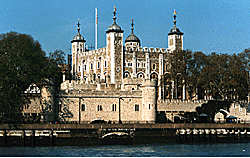After Williamís victory at Hastings, he preceded to wait for the Anglo-Saxon envoys to arrive and offer their surrender. He waited for five days and when no envoys were forthcoming, he set out with his army to force their capitulation. He then marched on the large port city of Dover which then submitted to him. He erected a third motte-and-bailey castle at Dover on the remains of another old Roman fort. Now, with his three castles, he controlled the Kentish peninsula and had a secure base of operations from which to carry out his further actions against the stubborn Anglo-Saxons.
At the same time he was taking Dover, he sent out a force of five hundred to punish the town of Old Romney for their massacre of Normans who had accidentally been blown off course during his initial invasion. During the taking of Dover, a large number of his force came down with dysentery including himself. He left the sick behind and then continued on in his campaign to take London. When Duke William attempted to take London by surprise, his mounted detachment were met by a strong Anglo-Saxon city garrison and turned. The Norman detachment skirmished with the soldiers sent out from London and fired the town of Southwark before rejoining the main Norman group.
 Tower of London originally built by William the Conqueror Photo by David W Tschanz.
Tower of London originally built by William the Conqueror Photo by David W Tschanz.
William continued to lead his forces via a southerly route around London. His mounted forces razed the lands and captured or caused numerous towns and villages to submit to Norman rule. It was during Williamís long-march toward London that Archbishop Stigard and Ealdred of York had the Edgar Atheling crowned as the new King. However, this came to naught and the Anglo-Saxons could or would not throw their support behind King Edgar. London was stricken with panic of Williamís approach.
By mid-November, Williamís forces took the city of Wallingford and erected a castle to control this city at Berkhamsted. Archbishop Stigard --who surrendered to William as well as bringing news that London was willing to submit-- met William at Wallingford. Simultaneously, there also appears to have been a meeting by the remaining Anglo-Saxon leadership about the same time to elect a new King to carry on the fight against William; however, they could not agree upon a leader and fled to the north from Williamís advancing forces. The magnates and churchmen in London convinced William to accept the English throne.
He was crowned the new King of England in Westminster Abbey on Christmas Day 1066. At the same time, William started the construction of a fortification to control the city of London. This fortification would later be known as the Tower of London. William carried out one more short campaign against Barking which completed the submission of London to Norman rule.
William then returned to Normandy leaving Bishop Odo, his half brother, and William fitz Osbern, his steward, in charge of England with other associated magnates to assist them in the running of the kingdom. William -in grand style-- traveled to Normandy accompanied by a great number of Anglo-Saxon hostages, and celebrated his victory and new title of King of England in both Rouen and the ducal monastery at Feícamp.
Bishop Odo and William fitz Osbern, in their rule of England, were forced to contend with Anglo-Saxon rebellions and the threat of overseas invasions. These threats led to King Williamís return to England where he was faced by three major threats to his newly-won kingdom. First, his victory had made him the most powerful of the vassals to the King of France, who was growing into manhood and would have to take eventual action to keep William from becoming too powerful.
Second, William only controlled the southeastern portion of England and had to face rebellious local lords as well as settling the disputed border territories with the Welsh princes and the Scottish King. And, finally, there still remained a Nordic threat to his kingdom from the remaining Scandinavian rulers who still desired England to remain in their political orbit.
More Role of Castles in William the Conqueror's Victory
-
Introduction
Opposing Forces: Anglo-Saxon and Norman
Battle Of Hastings
Fortifications and Castles in England
Post Hastings Conquest
1067-70, Williamís Kingdom in Peril
Conclusion, Appendix, and References
Back to Cry Havoc #34 Table of Contents
Back to Cry Havoc List of Issues
Back to MagWeb Master Magazine List
© Copyright 2001 by David W. Tschanz.
This article appears in MagWeb (Magazine Web) on the Internet World Wide Web. Other military history articles and gaming articles are available at http://www.magweb.com